Related Research Articles
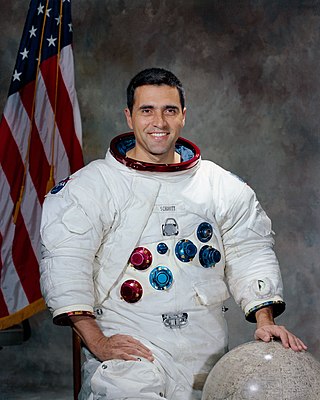
Harrison Hagan Schmitt is an American geologist, retired NASA astronaut, university professor, former U.S. senator from New Mexico, and the most recent living person—and only person without a background in military aviation—to have walked on the Moon.

The age of Earth is estimated to be 4.54 ± 0.05 billion years (4.54 × 109 years ± 1%). This age may represent the age of Earth's accretion, or core formation, or of the material from which Earth formed. This dating is based on evidence from radiometric age-dating of meteorite material and is consistent with the radiometric ages of the oldest-known terrestrial material and lunar samples.

Meteor Crater or Barringer Crater is a meteorite impact crater about 37 mi (60 km) east of Flagstaff and 18 mi (29 km) west of Winslow in the desert of northern Arizona, United States. The site had several earlier names, and fragments of the meteorite are officially called the Canyon Diablo Meteorite, after the adjacent Canyon Diablo.
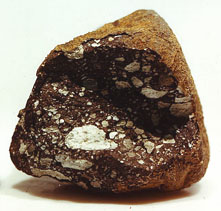
A lunar meteorite is a meteorite that is known to have originated on the Moon. A meteorite hitting the Moon is normally classified as a transient lunar phenomenon.

A Moon landing or lunar landing is the arrival of a spacecraft on the surface of the Moon. This includes both crewed and robotic missions. The first human-made object to touch the Moon was the Soviet Union's Luna 2, on 13 September 1959.

Carbonado, commonly known as black diamond, is one of the toughest forms of natural diamond. It is an impure, high-density, micro-porous form of polycrystalline diamond consisting of diamond, graphite, and amorphous carbon, with minor crystalline precipitates filling pores and occasional reduced metal inclusions. Titanium nitride has been found in carbonado. It is found primarily in alluvial deposits where it is most prominent in mid-elevation equatorial regions such as Central African Republic and in Brazil, where the vast majority of carbonado diamondites have been found. Its natural colour is black or dark grey, and it is more porous than other diamonds.
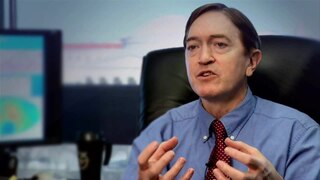
The geology of the Moon is quite different from that of Earth. The Moon lacks a true atmosphere, and the absence of free oxygen and water eliminates erosion due to weather. Instead, the surface is eroded much more slowly through the bombardment of the lunar surface by micrometeorites. It does not have any known form of plate tectonics, it has a lower gravity, and because of its small size, it cooled faster. In addition to impacts, the geomorphology of the lunar surface has been shaped by volcanism, which is now thought to have ended less than 50 million years ago. The Moon is a differentiated body, with a crust, mantle, and core.
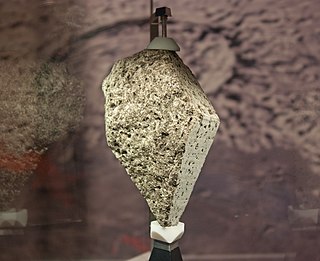
Moon rock or lunar rock is rock originating from Earth's Moon. This includes lunar material collected during the course of human exploration of the Moon, and rock that has been ejected naturally from the Moon's surface and landed on Earth as meteorites.
Haggertyite is a rare barium, iron, magnesium, titanate mineral: Ba(Fe2+6Ti5Mg)O19 first described in 1996 from the Crater of Diamonds State Park near Murfreesboro in Pike County, Arkansas. The microscopic metallic mineral crystallizes in the hexagonal system and forms tiny hexagonal plates associated with richterite and serpentinitized olivine of mafic xenoliths in the lamproite host rock. It is an iron(II) rich member of the magnetoplumbite group. It is a light grey opaque mineral with calculated Mohs hardness of 5.

Troilite is a rare iron sulfide mineral with the simple formula of FeS. It is the iron-rich endmember of the pyrrhotite group. Pyrrhotite has the formula Fe(1-x)S which is iron deficient. As troilite lacks the iron deficiency which gives pyrrhotite its characteristic magnetism, troilite is non-magnetic.

A sample-return mission is a spacecraft mission to collect and return samples from an extraterrestrial location to Earth for analysis. Sample-return missions may bring back merely atoms and molecules or a deposit of complex compounds such as loose material and rocks. These samples may be obtained in a number of ways, such as soil and rock excavation or a collector array used for capturing particles of solar wind or cometary debris. Nonetheless, concerns have been raised that the return of such samples to planet Earth may endanger Earth itself.
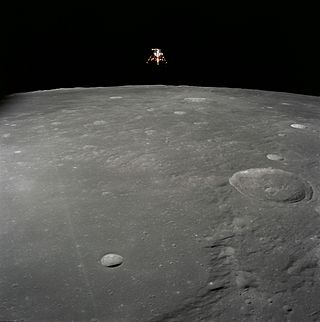
The physical exploration of the Moon began when Luna 2, a space probe launched by the Soviet Union, made an impact on the surface of the Moon on September 14, 1959. Prior to that the only available means of exploration had been observation from Earth. The invention of the optical telescope brought about the first leap in the quality of lunar observations. Galileo Galilei is generally credited as the first person to use a telescope for astronomical purposes; having made his own telescope in 1609, the mountains and craters on the lunar surface were among his first observations using it.
Stuart Olof Agrell was an optical mineralogist and a pioneer in applications of the electron microprobe to petrology. His involvement as a principal investigator in the analysis of Moon rocks collected in the Apollo program brought him to the attention of the British media and public.
Edward Ching-Te Chao was one of the founders of the field of impact metamorphism, the study of the effects of meteorite impacts on the Earth's crust.
John Hoffman was a space scientist who developed instruments for Apollo 15, Apollo 16, Apollo 17, the Pioneer Venus project, and Giotto mission. He also designed the mass spectrometer for the Phoenix Mars Lander mission in May 2008. He was a professor of physics at the University of Texas at Dallas.
Tranquillityite is silicate mineral with formula (Fe2+)8Ti3Zr2 Si3O24. It is mostly composed of iron, oxygen, silicon, zirconium and titanium with smaller fractions of yttrium and calcium. It is named after the Mare Tranquillitatis (Sea of Tranquility), the place on the Moon where the rock samples were found during the 1969 Apollo 11 mission. It was the last mineral brought from the Moon which was thought to be unique, with no counterpart on Earth, until it was discovered in Australia in 2011.

The Lunar Sample Laboratory Facility (LSLF) is a repository and laboratory facility at NASA's Lyndon B. Johnson Space Center in Houston, Texas, opened in 1979 to house geologic samples returned from the Moon by the Apollo program missions to the lunar surface between 1969 and 1972. The facility preserves most of the 382 kilograms (842 lb) of lunar material returned over the course of Apollo program and other extraterrestrial samples, along with associated data records. It also contains laboratories for processing and studying the samples without contamination.

Barbara Cohen is a planetary scientist at NASA's Goddard Space Flight Center. The asteroid 6816 Barbcohen is named after her.

Lunar Sample 14321, better known as "Big Bertha", is a lunar sample containing an embedded Earth-origin meteorite collected on the 1971 Apollo 14 mission. It was found in the Fra Mauro region of the Moon. Big Bertha is the first discovered meteorite from Earth, and the embedded meteorite portion is the oldest known Earth rock. At 8.998 kg (19.84 lb), this breccia rock is the third largest Moon sample returned during the Apollo program, behind Big Muley and Great Scott.
Edward Anders is a Latvian-born American chemist and emeritus professor of chemistry at the University of Chicago. His major areas of research have included the origin and ages of meteorites, the existence of presolar grains in meteorites, the solar-system abundance of chemical elements, and mass extinctions in earth history. In the 1970s, he was one of the 142 principal investigators who studied lunar samples brought back to Earth by the Apollo program. After retiring from scientific research in 1991, he became a prominent researcher, speaker and writer on issues related to the Holocaust in Latvia.
References
- ↑ "Fulbright Scholar Stories: Stephen Haggerty". Archived from the original on 2011-09-17. Retrieved 2012-01-19.
- ↑ Gray, Ian E.; et al. (1998). "Haggertyite, a new magnetoplumbite-typte titanate mineral from the Prairie Creek (Arkansas) lamproite" (PDF). American Mineralogist . 83 (11–12): 1323–1329. Bibcode:1998AmMin..83.1323G. doi:10.2138/am-1998-11-1221.
- 1 2 "Stephen E. Haggerty". Massachusetts University. Retrieved 2012-01-19.
- 1 2 "Stephen E. Haggerty - CV" (PDF). Florida International University. Retrieved 2012-01-19.
- ↑ "Mystery Diamonds". Science Daily . 2007-06-01. Retrieved 2012-01-19.
- ↑ Sasso, Anne (January 2008). "60. Diamonds From Outer Space". Discover Magazine .